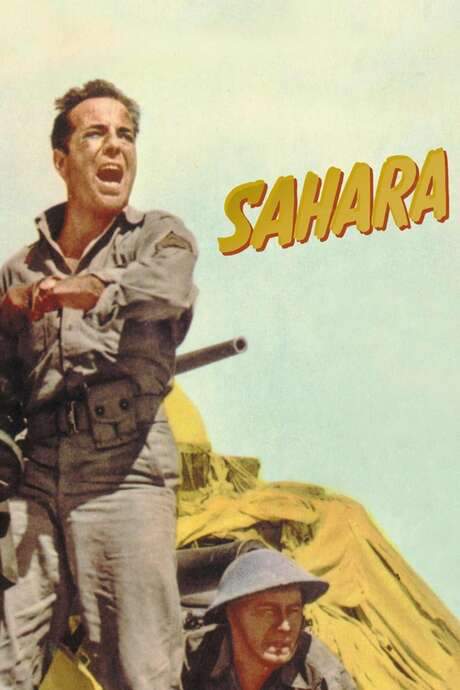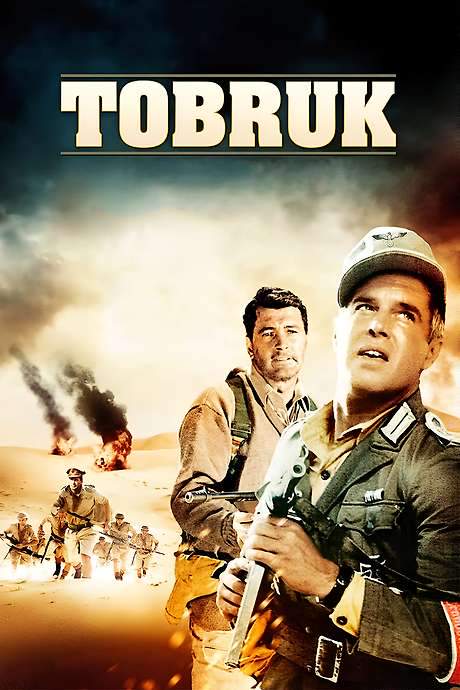
Sahara
Year: 1943
Runtime: 97 mins
Language: English
Director: Zoltan Korda
Set amid the harsh Libyan desert during the Western Desert Campaign of World II, an American tank commander and a small group of Allied soldiers are tasked with defending an isolated well that holds a scarce water supply. They must hold the well against a determined German Afrika Korps battalion, fighting under extreme conditions to keep the vital resource from falling into enemy hands.
Warning: spoilers below!
Haven’t seen Sahara yet? This summary contains major spoilers. Bookmark the page, watch the movie, and come back for the full breakdown. If you're ready, scroll on and relive the story!
Sahara (1943) – Full Plot Summary & Ending Explained
Read the complete plot breakdown of Sahara (1943), including all key story events, major twists, and the ending explained in detail. Discover what really happened—and what it all means.
In 1942, the crew of Lulubelle, a United States Army M3 Lee tank attached to the British Eighth Army and led by Sgt. Joe Gunn, Humphrey Bogart, becomes separated from their unit during a general retreat from German forces after Tobruk falls. They push south across the blistering Libyan Desert, relying on grit and improvisation as they improvise a route with their mechanic and gunner in tow. Doyle, Dan Duryea, and Waco Hoyt, Bruce Bennett, form the core of the improvised crew, while they encounter a battered field hospital and briefly take aboard Captain Halliday, Richard Aherne, along with four Commonwealth soldiers and Free French Corporal Leroux, Louis Mercier. Halliday, the only officer among them, recognizes Gunn’s experience and hands over command, trusting Gunn’s practical leadership to steer them through a landscape that offers little mercy and even less water.
As the tank moves across the scorched sands, Tambul, Rex Ingram, a Sudan Defence Force Sergeant Major, appears with an Italian prisoner, Giuseppe, and Tambul volunteers to guide the group to a distant well at Hassan Barani. Gunn haltingly agrees to let Giuseppe join, despite his initial misgivings about the stranger in their ranks. The convoy’s fragile cohesion is tested when a Luftwaffe strike led by Captain von Schletow, Kurt Kreuger, strafes the procession, wounding Fred Clarkson, Lloyd Bridges in the blast. Von Schletow is himself shot down and captured, leaving Gunn’s group to cope with the consequences of a wounded comrade and the unsettling reality of a pursuing enemy.
At Hassan Barani, the well is dry, and the group confronts the bitter truth that thirst can be as deadly as enemy fire. Clarkson’s condition worsens, and they push on to Bir Acroma, where a trickle of water offers a grim reprieve. Yet as they haul as much water as they can, German scouts close in with a mechanized battalion hungry for both liquid and leverage. Gunn seizes a desperate option: he holds back from a direct clash and, instead, uses deception to stall the enemy, proposing that the well contains more water than it does, while sending Waco to fetch reinforcements. The ploy buys time but cannot erase the reality of their precarious situation.
The first sustained clash with Major von Falken, John Wengraf, arrives as the Germans reach the outskirts. Gunn maintains the illusion of abundance, and when negotiations briefly resume, von Falken’s confidence grows. The German commander refuses the ruse and presses a frontal assault, exacting a toll on the Allied defenders. In the heat of battle, Giuseppe is stabbed by von Schletow after voicing his defiance against fascism and his desire to escape, yet not before he can pass a crucial warning to Gunn. Tambul gives chase and shoots Von Schletow in a bid to break the German line, but Tambul himself falls to a gunfire that ends his life. The action heightens the stakes, and Leroux, Louis Mercier, faces a harsh betrayal as von Falken orders Leroux shot in the back as he attempts to return to Allied lines; the act starkly underscores the brutality of the siege.
The stalemate with von Falken’s forces deepens, and Gunn’s small force finds itself pressed from multiple directions. As the German assault swells, the battlefield unexpectedly shifts again when a shell crater near the well seems to tap into a hidden source of water, shocking the defenders with its sudden return. The Germans’ weapons drop their edge as panic and thirst mingle with fatigue, and Gunn, along with Bates, the remaining Allied survivor—Ozzie Bates, Patrick O’Moore—seizes the moment to disarm the encroaching soldiers and establish a fragile ceasefire.
With the German soldiers surrendering to the desolate desert and their weapons laid aside, the Allied group moves their prisoners east under the watch of Waco Hoyt, who had remained steady and vigilant throughout the ordeal. The news of a turning tide arrives in the form of Allied troops approaching, and the survivors are guided toward safety. The sequence of events culminates with word of the Allied victory at the First Battle of El Alamein, a turning point that sends Rommel’s Afrika Korps retreating and signals a renewed push by Allied forces across the desert.
Throughout the ordeal, Gunn embodies a blend of stubborn resolve and practical leadership, improvising in the face of dwindling resources and withering heat. The bond among the crew—Gunn at the helm, Doyle keeping the engine and weapons in check, and Waco supporting from the turret—becomes their last line of defense against an enemy that knows no mercy. The crew’s endurance is matched by the desert’s unforgiving vastness, every mile bringing them closer to a contested horizon where courage, cunning, and a measure of luck determine who survives and who does not.
In the end, the story remains a testament to the grit of a small band of soldiers who, against overwhelming odds, hold the line long enough for Allied forces to arrive and claim a hard-won victory. The desert’s heat and dust forge their resolve, and the battle’s outcome—decisive but costly—echoes through the survivors’ march toward the east, where the war’s tides begin to turn in favor of those who refused to yield.
Last Updated: October 09, 2025 at 12:38
Unlock the Full Story of Sahara
Don't stop at just watching — explore Sahara in full detail. From the complete plot summary and scene-by-scene timeline to character breakdowns, thematic analysis, and a deep dive into the ending — every page helps you truly understand what Sahara is all about. Plus, discover what's next after the movie.
Sahara Timeline
Track the full timeline of Sahara with every major event arranged chronologically. Perfect for decoding non-linear storytelling, flashbacks, or parallel narratives with a clear scene-by-scene breakdown.

Similar Movies to Sahara
Discover movies like Sahara that share similar genres, themes, and storytelling elements. Whether you’re drawn to the atmosphere, character arcs, or plot structure, these curated recommendations will help you explore more films you’ll love.
Explore More About Movie Sahara
Sahara (1943) Scene-by-Scene Movie Timeline
Sahara (1943) Movie Characters, Themes & Settings
Sahara (1943) Spoiler-Free Summary & Key Flow
Movies Like Sahara – Similar Titles You’ll Enjoy
Sahara (1995) Film Overview & Timeline
Sea of Sand (1958) Movie Recap & Themes
Desert Commandos (1967) Film Overview & Timeline
Sahara (1983) Ending Explained & Film Insights
Adventure in Sahara (1938) Spoiler-Packed Plot Recap
The Desert Rats (1953) Story Summary & Characters
Sahara (2005) Film Overview & Timeline
Desert Sands (1955) Ending Explained & Film Insights
Bitter Victory (1957) Movie Recap & Themes
Tobruk (1967) Complete Plot Breakdown
Lion of the Desert (1980) Full Movie Breakdown
Desert Command (1946) Ending Explained & Film Insights
The Battle of El Alamein (1969) Full Movie Breakdown
Tuareg: Desert Warrior (1984) Movie Recap & Themes
Ice Cold in Alex (1958) Detailed Story Recap

















